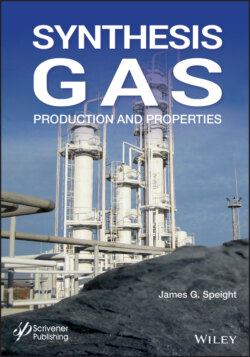Читать книгу Synthesis Gas - James Speight G., James G. Speight - Страница 51
2.5.5.3 Water Gas Shift Reaction
ОглавлениеThe water gas shift reaction (shift conversion) is necessary because the gaseous product from a gasifier generally contains large amounts of carbon monoxide and hydrogen, plus lesser amounts of other gases. Carbon monoxide and hydrogen (if they are present in the mole ratio of 1:3) can be reacted in the presence of a catalyst to produce methane. However, some adjustment to the ideal (1:3) is usually required and, to accomplish this, all or part of the stream is treated according to the waste gas shift (shift conversion) reaction. This involves reacting carbon monoxide with steam to produce a carbon dioxide and hydrogen whereby the desired 1:3 mole ratio of carbon monoxide to hydrogen may be obtained:
Even though the water gas shift reaction is not classified as one of the principal gasification reactions, it cannot be omitted in the analysis of chemical reaction systems that involve synthesis gas. Among all reactions involving synthesis gas, this reaction equilibrium is least sensitive to the temperature variation – the equilibrium constant is least strongly dependent on the temperature. Therefore, the reaction equilibrium can be reversed in a variety of practical process conditions over a wide range of temperature.
The water gas shift reaction in its forward direction is mildly exothermic and although all of the participating chemical species are in gaseous form, the reaction is believed to be heterogeneous insofar as the chemistry occurs at the surface of the feedstock and the reaction is actually catalyzed by carbon surfaces. In addition, the reaction can also take place homogeneously as well as heterogeneously and a generalized understanding of the water gas shift reaction is difficult to achieve. Even the published kinetic rate information is not immediately useful or applicable to a practical reactor situation.
Synthesis gas from a gasifier contains a variety of gaseous species other than carbon monoxide and hydrogen. Typically, they include carbon dioxide, methane, and water (steam). Depending on the objective of the ensuing process, the composition of synthesis gas may need to be preferentially readjusted. If the objective of the gasification process is to obtain a high yield of methane, it would be preferred to have the molar ratio of hydrogen to carbon monoxide at 3:1:
On the other hand, if the objective of generating synthesis gas is the synthesis of methanol via a vapor-phase low-pressure process, the stoichiometrically consistent ratio between hydrogen and carbon monoxide would be 2:1. In such cases, the stoichiometrically consistent synthesis gas mixture is often referred to as balanced gas, whereas a synthesis gas composition that is substantially deviated from the principal stoichiometry of the reaction is called unbalanced gas. If the objective of synthesis gas production is to obtain a high yield of hydrogen, it would be advantageous to increase the ratio of hydrogen to carbon monoxide by further converting carbon monoxide (and water) into hydrogen (and carbon dioxide) via the water gas shift reaction.
The water gas shift reaction is one of the major reactions in the steam gasification process, where both water and carbon monoxide are present in ample amounts. Although the four chemical species involved in the water gas shift reaction are gaseous compounds at the reaction stage of most gas processing, the water gas shift reaction, in the case of steam gasification of feedstock, predominantly takes place on the solid surface of feedstock (hetero-geneous reaction). If the product synthesis gas from a gasifier needs to be reconditioned by the water gas shift reaction, this reaction can be catalyzed by a variety of metallic catalysts.
Choice of specific kinds of catalysts has always depended on the desired outcome, the prevailing temperature conditions, composition of gas mixture, and process economics. Typical catalysts used for the reaction include catalysts containing iron, copper, zinc, nickel, chromium, and molybdenum.
